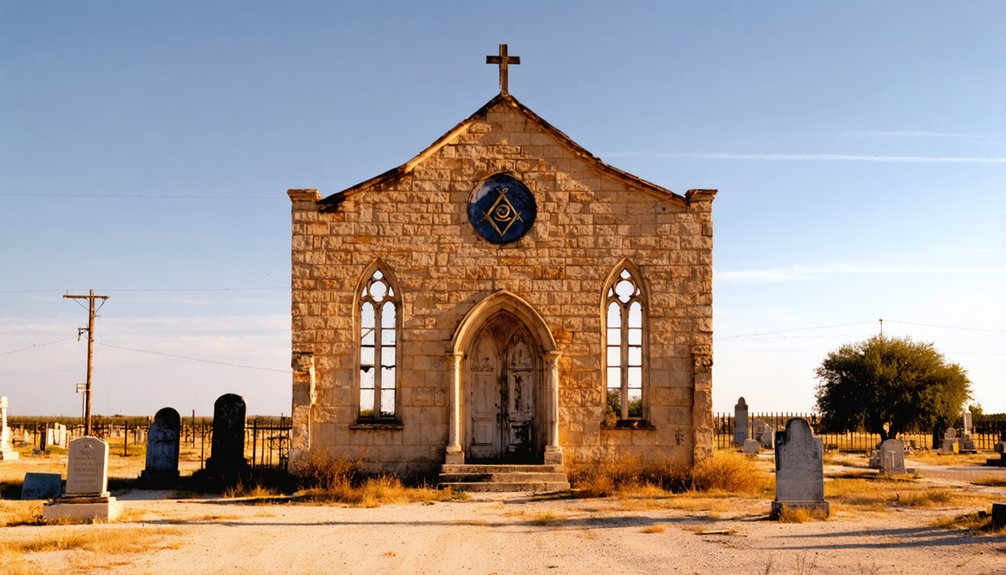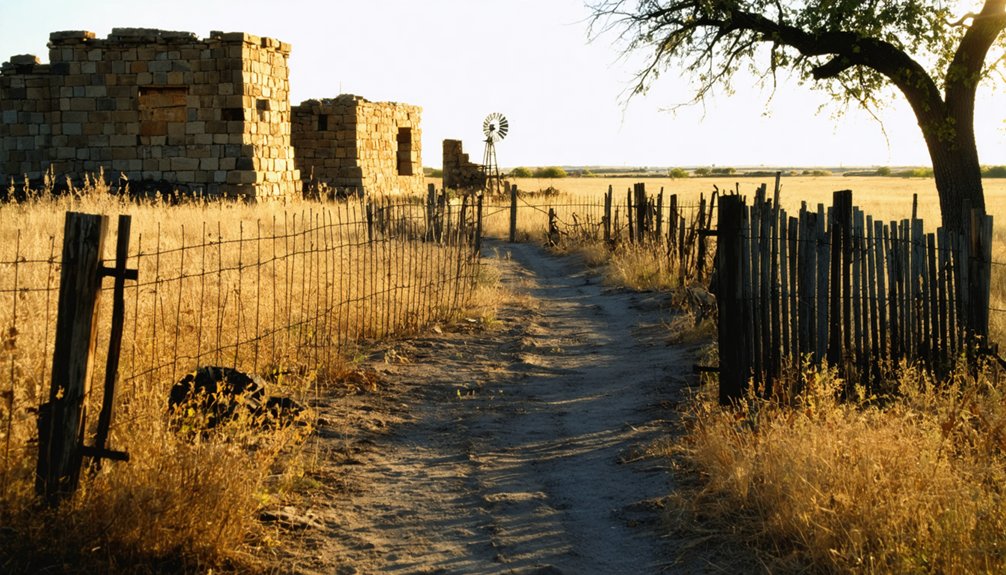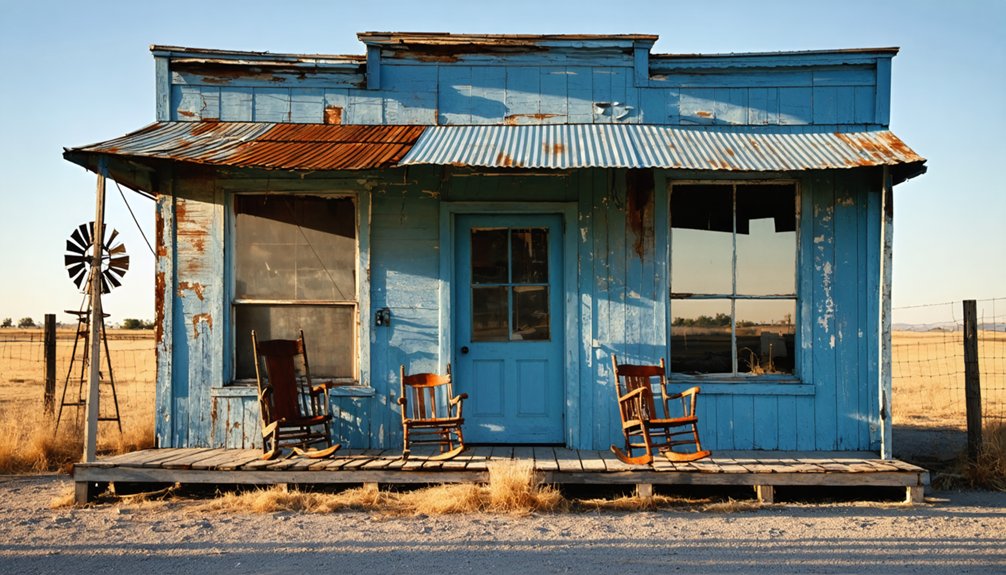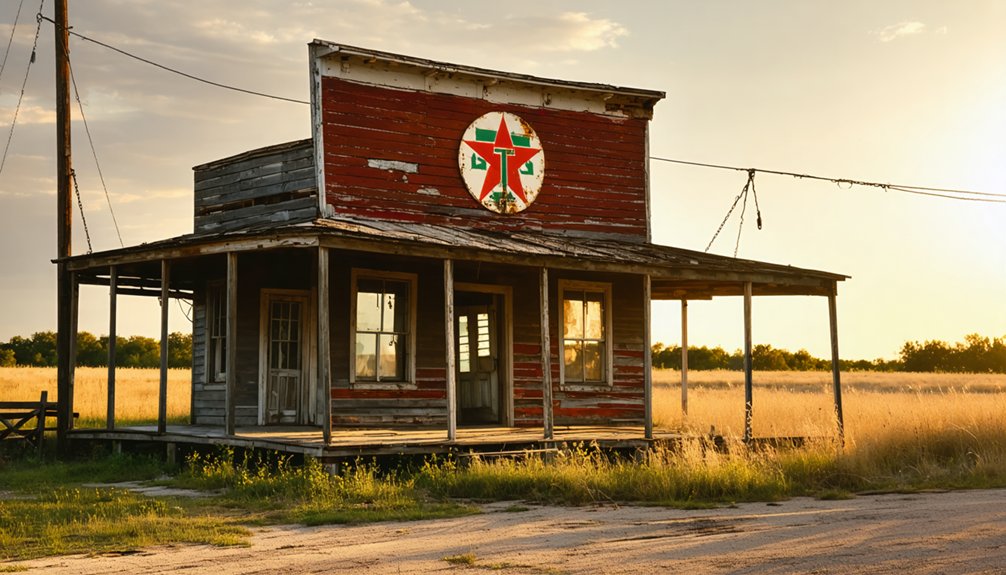You’ll find Elm Creek’s haunting remains 10 miles south of Newcastle, Texas, where this frontier settlement once thrived along the Chihuahua Trail. The community faced its darkest hour during the 1864 Kiowa and Comanche raid, which claimed multiple lives and left deep scars. Proffitt’s store, the Methodist church, and Masonic Lodge formed the heart of this resilient settlement until Indian raids and economic struggles led to its decline. The echoes of its pioneer spirit still whisper across the Brazos River valley.
Key Takeaways
- The settlement declined after the devastating 1864 Kiowa and Comanche raid, which killed twelve people and took six captives.
- Located at Elm Creek and Brazos River’s confluence, the community was a frontier settlement along the historic Chihuahua Trail.
- John Proffitt’s store, Methodist church, and Masonic Lodge served as vital community hubs until the settlement’s gradual abandonment.
- Lack of railroad connections, persistent Native American raids, and population loss contributed to Elm Creek becoming a ghost town.
- Historical preservation efforts include markers and oral history documentation to maintain the memory of this Texas frontier settlement.
The Birth of a Texas Frontier Settlement
Three key elements shaped the birth of Elm Creek settlement in northern Young County, Texas: its strategic location, diverse community, and precarious position on the frontier.
You’ll find this settlement nestled where Elm Creek meets the Brazos River, positioned along the historic Chihuahua Trail and just 10 miles south of Newcastle.
The community’s frontier challenges emerged from its position between civilization and the untamed West, where settlers faced the complex task of building lives in contested territory. The area became particularly dangerous after the Warren Wagon massacre in 1871 heightened tensions between settlers and Native Americans. The settlers relied heavily on wild game and native fruits to sustain their families through difficult times.
Despite the risks, a resilient mix of people, including African-American families like the Johnsons and white families such as the Fitzpatricks and Braggs, established scattered homesteads.
They’d adapt to frontier life by constructing defensive palisades and forging bonds that crossed racial lines, all while living under Fort Belknap’s distant watch.
Daily Life Along Elm Creek’s Banks
Life along Elm Creek’s banks revolved around both survival and community building, as settlers adapted to the harsh realities of frontier existence. You’d find families scattered in homesteads, tending to cattle and small farms while staying alert for threats.
Daily routines included managing livestock, maintaining makeshift shelters, and watching for rattlesnakes and scorpions that made frontier life precarious. John Proffitt’s store, opened in 1894, became a vital hub for supplies and community interaction. The severe drought conditions tested the resilience of local cattlemen and farmers throughout the year.
Community gatherings centered around the Methodist Episcopal church and Masonic Lodge, where you’d join neighbors for worship and social connection.
When men weren’t away on cattle drives or supply runs to Weatherford, they’d work together to protect their homes.
Despite the isolation and dangers, you’d see a growing sense of permanence through the establishment of schools, churches, and a cemetery – signs of a determined community taking root in challenging territory.
The Fateful October Raid of 1864
On the morning of October 13, 1864, while most men were away on cattle roundups, a massive force of 600 to 1100 Kiowa and Comanche warriors descended upon the scattered homesteads along Elm Creek.
Their raid strategies were devastating – targeting vulnerable settlements and overwhelming Confederate soldiers who tried to defend them. You’d have witnessed the chaos as warriors swept through the valley, killing seven settlers and five soldiers while taking six women and children captive.
The cultural implications of this attack ran deep, sparked by Kiowa Chief Little Buffalo’s vision of conquest. Among the victims was Elizabeth FitzPatrick’s family, who were taken captive during the brutal assault. A historical marker now stands near Newcastle to commemorate this tragic event.
The raiders stole 10,000 cattle and shattered the community’s sense of security.
Despite rescue attempts by Britton Johnson, who later gained the Comanches’ trust, this raid stands as one of the most significant frontier attacks during the Civil War era.
Tales of Survival and Loss
You’ll find stories of remarkable bravery among Elm Creek’s settlers, like Peter and Perry Harmonson who fought off attackers with firearms, while others hid in dense brush or repeatedly crossed the creek to confuse their pursuers.
The October 1864 raid tore families apart, with Elizabeth Fitzpatrick forced to witness unspeakable violence, and approximately fourteen settlers killed or taken captive during the assault. The settlers at Bragg’s Fort managed to hold their ground during an intense six-hour battle. The raid involved approximately six hundred Indians from the Kiowa and Comanche tribes who descended upon the settlement.
Despite these devastating losses, survivors like the Hambys and Harmonsons showed extraordinary resilience, attempting to rebuild their community even under the constant threat of future attacks.
Brave Settlers’ Desperate Moments
During the harrowing Elm Creek Raid of October 1864, settlers faced unimaginable terror as 600 to 1100 Kiowa and Comanche warriors descended upon their scattered homesteads.
With most men away on a cattle roundup, survival depended on quick thinking and settler bravery. The raiders managed to steal an estimated 10,000 cattle during their devastating attack.
You’ll find stories of remarkable courage, like Thornton Hamby’s strategic defense that saved numerous lives. As families fled to caves along Elm Creek, he held off attackers with retreating fire.
Tom Wilson’s swift actions to warn neighbors gave precious minutes for escape. Survival tactics included hiding in dense brush and defending homesteads with gunfire.
Despite their valiant efforts, seven settlers and five Confederate soldiers lost their lives. Those who survived did so through a combination of prior frontier experience, decisive action, and sheer determination.
Lasting Impact On Families
The lives shattered during the Elm Creek Raid left deep wounds that shaped families for generations to come.
You’ll find stories of profound family trauma in the experiences of the Fitzpatricks, Durkins, and Johnsons, who lost loved ones to violence and captivity. The raid tore children from parents, claimed innocent lives, and forced survivors to rebuild from nothing. Elijah Carter met a horrific end when he was burned alive by raiders during the captives’ forced journey northwest.
Yet through this darkness, you’ll discover remarkable community resilience. Families banded together in fortified homesteads, developed warning systems, and protected each other in caves and shelters.
The mixed-race families and African American settlers, like Britton Johnson’s family, faced doubled hardships but persevered. While many eventually left Elm Creek as a ghost town, their legacy of survival and shared sacrifice lives on through generations of descendants who still tell their stories.
The Methodist Church and Masonic Legacy

You’ll find early traces of Methodist life woven into Elm Creek’s fabric through the humble wooden church building that served both as a sacred gathering place and community anchor in the 1880s.
When Native American raids threatened the area’s settlers, the brotherhood between church members and local Masonic lodge affiliates strengthened their collective resolve to protect their spiritual home.
Through fires, relocations, and frontier challenges, the Methodist congregation’s determination to maintain their church reflected the wider community’s fighting spirit, with both Sunday services and lodge meetings continuing despite the dangers that lurked beyond settlement boundaries.
Sacred Gathering Place History
Since its early pioneer days, Elm Creek’s Methodist presence emerged as an essential spiritual cornerstone of the community, beginning with revival meetings in the 1880s and the establishment of Elm Grove Church in 1884.
You’d find sacred rituals taking place in makeshift spaces, from old schoolhouses to outdoor gatherings under trees, where pioneer families would join in prayer and fasting before quarterly meetings.
The community’s resourcefulness shone through as they built their first churches using timber from Elm Creek itself.
While starting with dirt floors and simple wooden benches, these sacred spaces evolved to serve multiple purposes.
Local women’s groups became instrumental in preserving these gathering places, organizing fundraisers and maintaining the buildings that stood as symbols of community resilience through generations.
Lodge Brotherhood During Raids
Beyond their spiritual connection through Methodist worship, Elm Creek’s pioneers found strength in another powerful brotherhood during times of uncertainty. The Masonic lodge, intertwined with Methodist leadership, served as a crucial hub of lodge unity and community defense during frontier raids.
You’d find nearly two-thirds of Methodist preachers belonging to the order, creating a powerful network of mutual support and protection.
When raids threatened the settlement, the lodge brotherhood mobilized quickly, sharing intelligence and coordinating defensive efforts. Their shared values of morality, discipline, and fraternity proved indispensable in maintaining order during chaos.
The lodge’s presence offered both practical security and emotional solidarity, while its networks facilitated rebuilding efforts after attacks. This powerful alliance between church and lodge helped guarantee Elm Creek’s survival through its most challenging periods.
Spiritual Community Under Fire
While frontier challenges tested Elm Creek’s spiritual foundations, the Methodist Church emerged as a resilient cornerstone of community life in 1885 under Rev. F.O. Miller, followed shortly by Rev. J.B. Minnis.
You’ll find that Methodist growth in the region reflected Texas-wide expansion, eventually contributing to the 1939 consolidation that united over 475,000 members across various Methodist branches.
Women’s mission work became particularly essential to Elm Creek’s spiritual vitality, as local auxiliary societies supported both domestic and international initiatives.
You can trace their increasing influence through their election as conference delegates by 1919. The church’s impact extended beyond worship, establishing educational institutions and social welfare programs that strengthened the entire community.
This Methodist presence, alongside German Lutheran influences, created a diverse spiritual landscape that defined Elm Creek’s character.
Strategic Location Near Fort Belknap

Located near the essential Fort Smith-El Paso Road, Elm Creek benefited immensely from its proximity to Fort Belknap, which was established in 1851 as a northern anchor in Texas’ frontier defense line.
You’d find Fort Belknap’s fort logistics centered on protecting settlers from Comanche and Kiowa raids while safeguarding critical trade routes that connected your community to the wider frontier.
Water sourcing played a decisive role in the area’s development. When the fort’s original location proved problematic due to inadequate water, despite 65-foot-deep shafts, it relocated two miles south near the Brazos River’s reliable springs.
This strategic placement near both Elm Creek and the Brazos guaranteed sustainable operations for the fort, its troops, and the growing settlements under its protection.
Echoes of the Past: Local Legends
Among Elm Creek’s most chilling tales, the legend of the Donkey Lady stands as a haunting reminder of frontier justice and tragedy.
You’ll find this haunting story deeply woven into local folklore, dating back to the mid-1800s when a settler’s wife was horrifically disfigured in an act of violence that claimed her family.
Today, the Donkey Lady Bridge serves as ground zero for countless ghost sightings and unexplained phenomena.
If you’re brave enough to visit after dark, you might hear the eerie screams that witnesses report or spot mysterious hoof-like marks on your vehicle.
This urban legend reflects the harsh realities of Texas frontier life, where class conflicts and survival often led to violence.
Unlike other regional ghost stories, the Donkey Lady’s unique human-animal transformation has captivated generations of locals.
The Community’s Gradual Decline

After the devastating Elm Creek Raid of 1864, this once-promising frontier settlement began a steady descent into decline.
Despite the community’s resilience, ongoing security threats from Indigenous raids severely disrupted settlement dynamics and economic stability.
You’ll find that several factors contributed to Elm Creek’s transformation into a ghost town:
- Persistent Indian depredations discouraged new settlers and drove existing residents away
- Absence of railroad connections isolated the community from crucial trade routes
- Loss of working-age men to cattle drives weakened community defense
- Geographic isolation deterred infrastructure investment and development
Preserving Elm Creek’s Historical Memory
Despite Elm Creek’s physical decline, dedicated efforts to preserve its historical legacy continue through various channels today.
Even as buildings crumble, passionate volunteers work tirelessly to protect and share Elm Creek’s rich history for generations to come.
You’ll find brown historical markers dotting the landscape, while local institutions maintain essential records and archives documenting the town’s story. Historical documentation includes oral histories from former residents and their descendants, preserving firsthand accounts of life in Elm Creek.
Community engagement thrives through volunteer groups and historical societies that organize preservation initiatives, cleanup events, and educational tours.
They’re working against time to photograph remaining structures and maintain historical markers despite funding limitations. While steering through complex property rights and zoning regulations, these dedicated preservationists collaborate with environmental agencies to protect both the cultural heritage and natural landscape of Elm Creek for future generations.
Frequently Asked Questions
Are There Any Descendants of Elm Creek Raid Survivors Still Living Nearby?
You’ll find descendants of Fitzpatrick and Johnson families still living nearby, as local history records and descendant interviews confirm their continued presence in Young County and surrounding communities.
What Artifacts From the Original Settlement Have Been Recovered?
Like buried treasures from a forgotten time, you’ll find picket house remains, domestic tools, wagon hardware, and foundation stones among the artifacts. The Wagner family mansion also left historically significant relics.
Did Any Native American Accounts of the Raid Survive?
You’ll find few direct Native accounts survived, though Kiowa oral traditions mention Chief Little Buffalo’s vision before the raid. Most historical narratives come filtered through settler and military perspectives.
Were There Other Major Raids on Elm Creek Besides 1864?
Lightning never strikes twice – historical records don’t show any additional raids matching the significance of the 1864 Elm Creek attack. You’ll find that fateful October stands alone in documented history.
What Happened to the Captured Settlers After the Raid?
You’ll find the captured settlers faced brutal fates after the raid aftermath – some were killed, like Elijah Carter who was burned alive, while others endured harsh journeys before being rescued through search efforts.
References
- https://digging-history.com/2015/01/07/ghost-town-wednesday-proffitt-texas/
- https://www.ycmohc.com/ghosts-of-elm-creek/
- http://sites.rootsweb.com/~txbaylor/1elmcree.htm
- https://texoso66.com/2022/06/02/elm-creek-massacre/
- https://www.historynet.com/search-captives-elm-creek/
- https://en.wikipedia.org/wiki/Old_Troy
- https://discovertexasoutdoors.com/places/elm-creek/
- https://www.tshaonline.org/handbook/entries/elm-creek-raid
- https://en.wikipedia.org/wiki/List_of_ghost_towns_in_Texas
- https://www.texasescapes.com/TexasGhostTowns/Eighteen-Ghost-Towns-of-Runnels-County.htm



